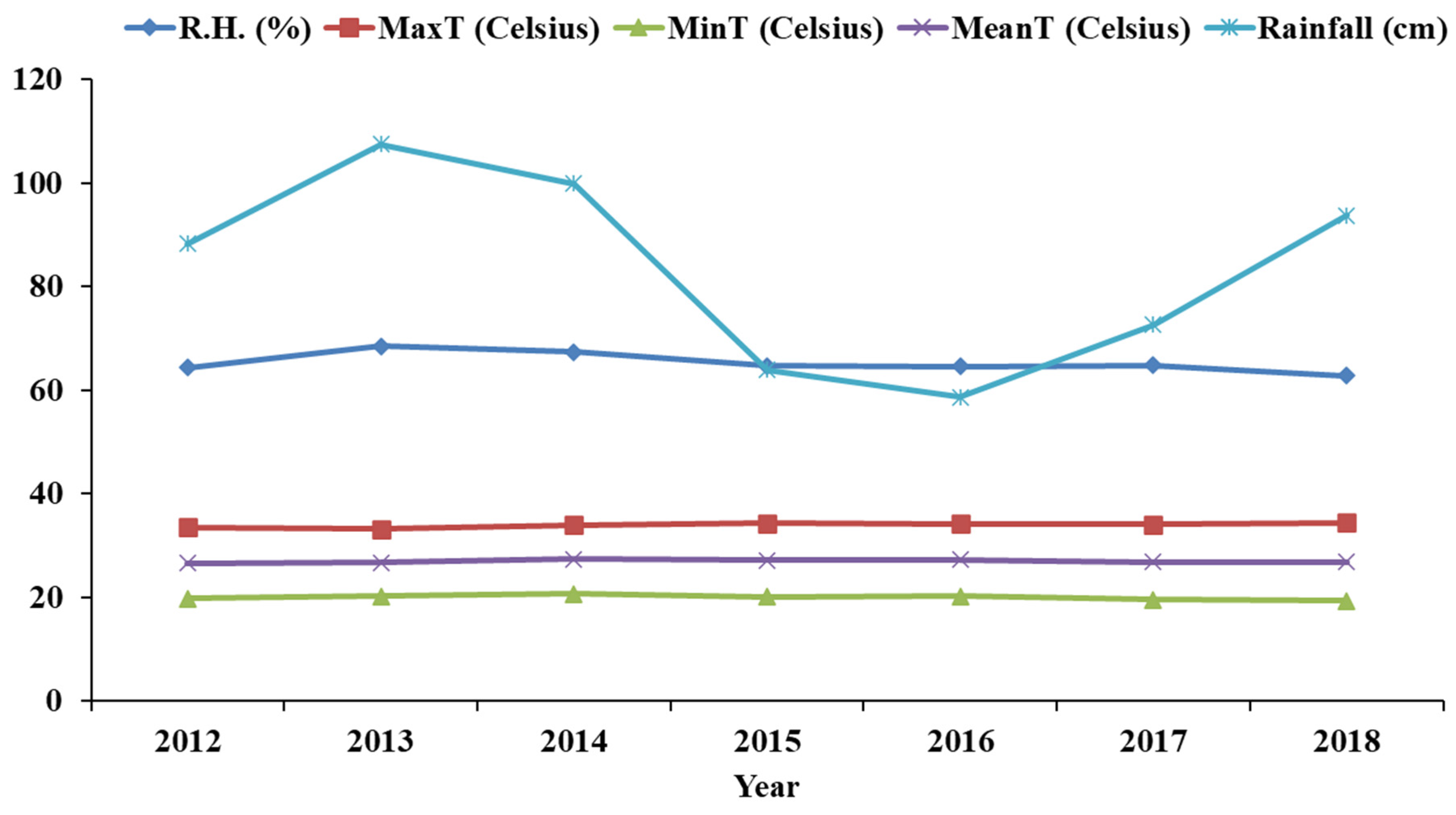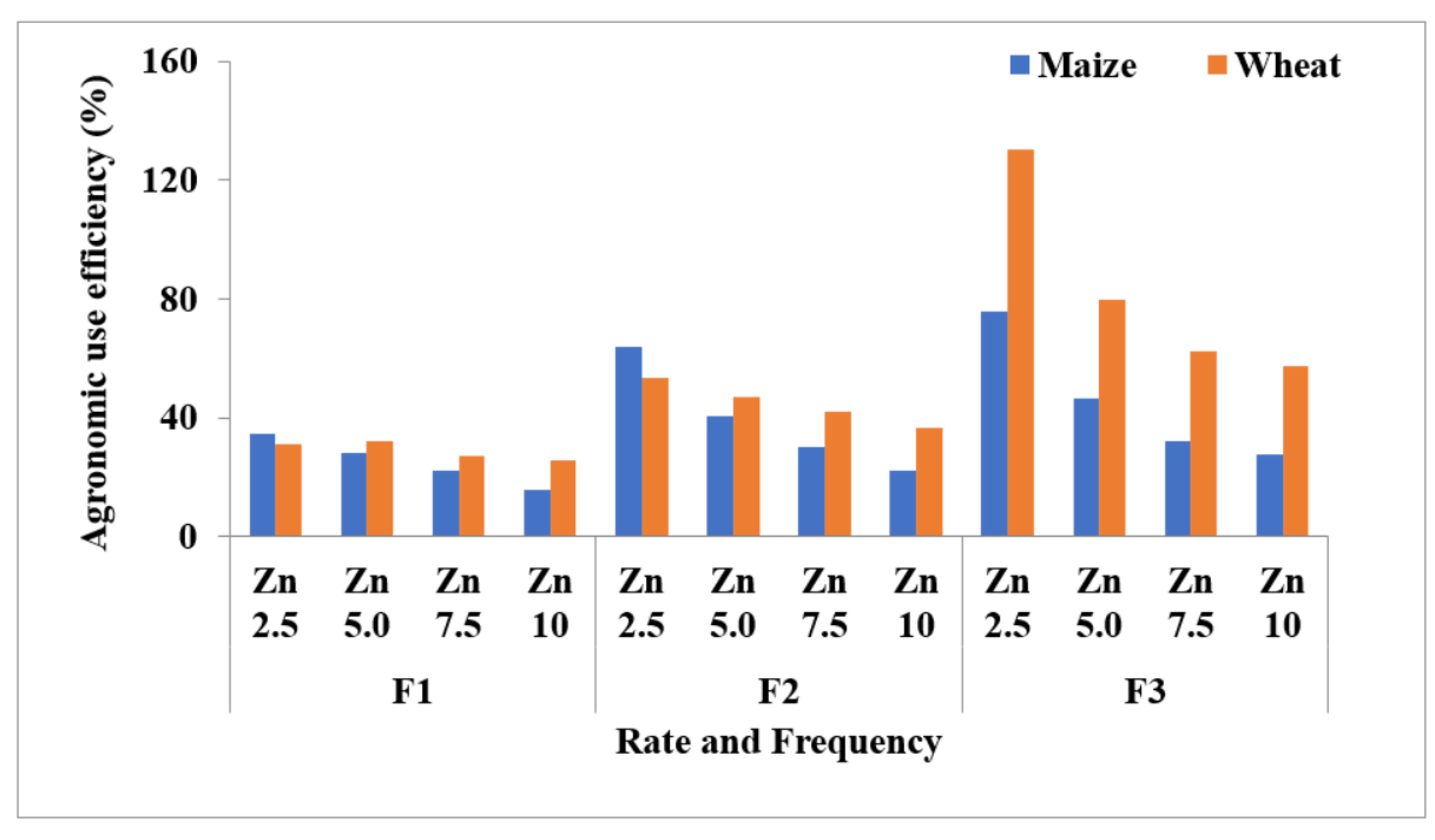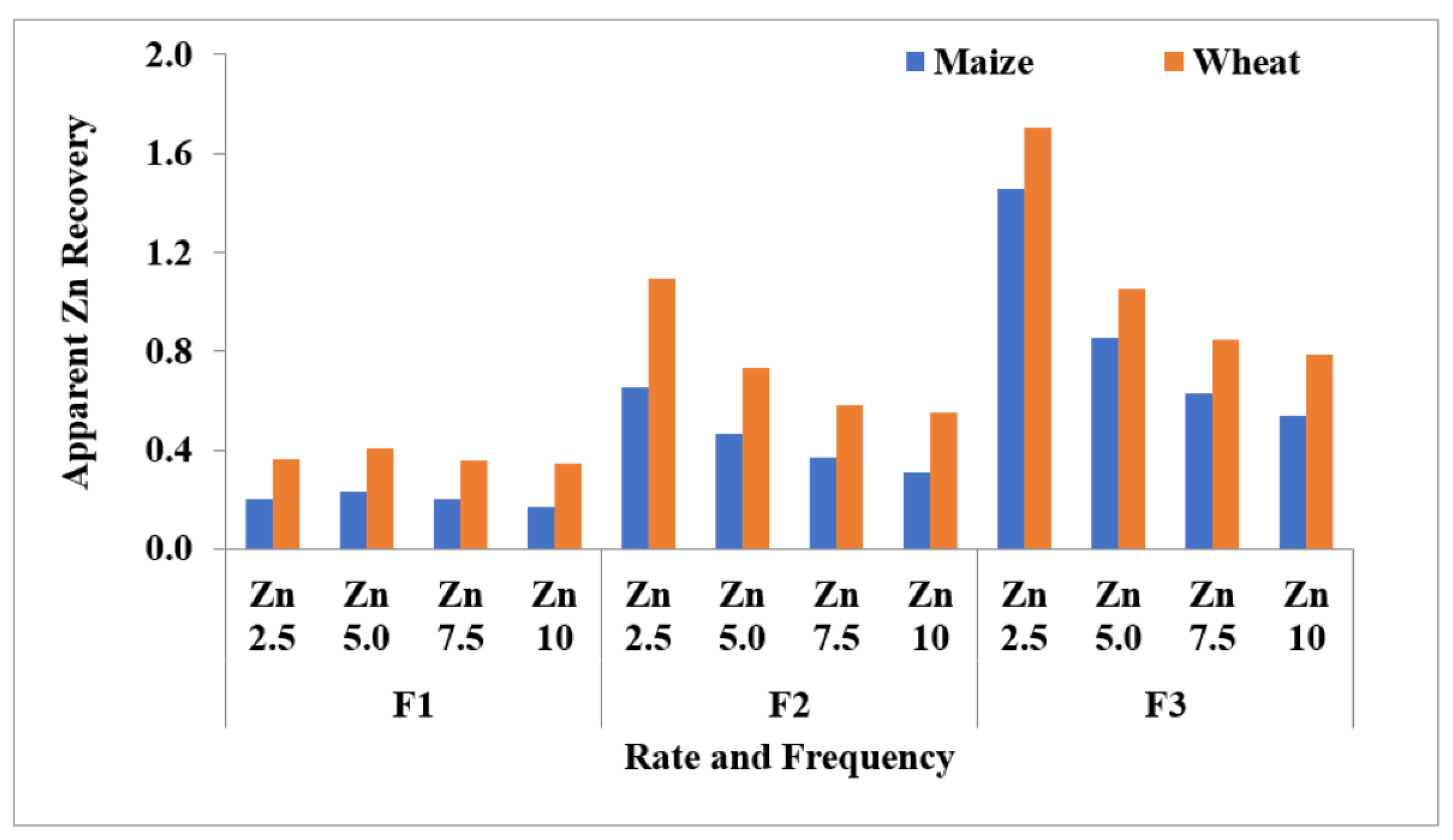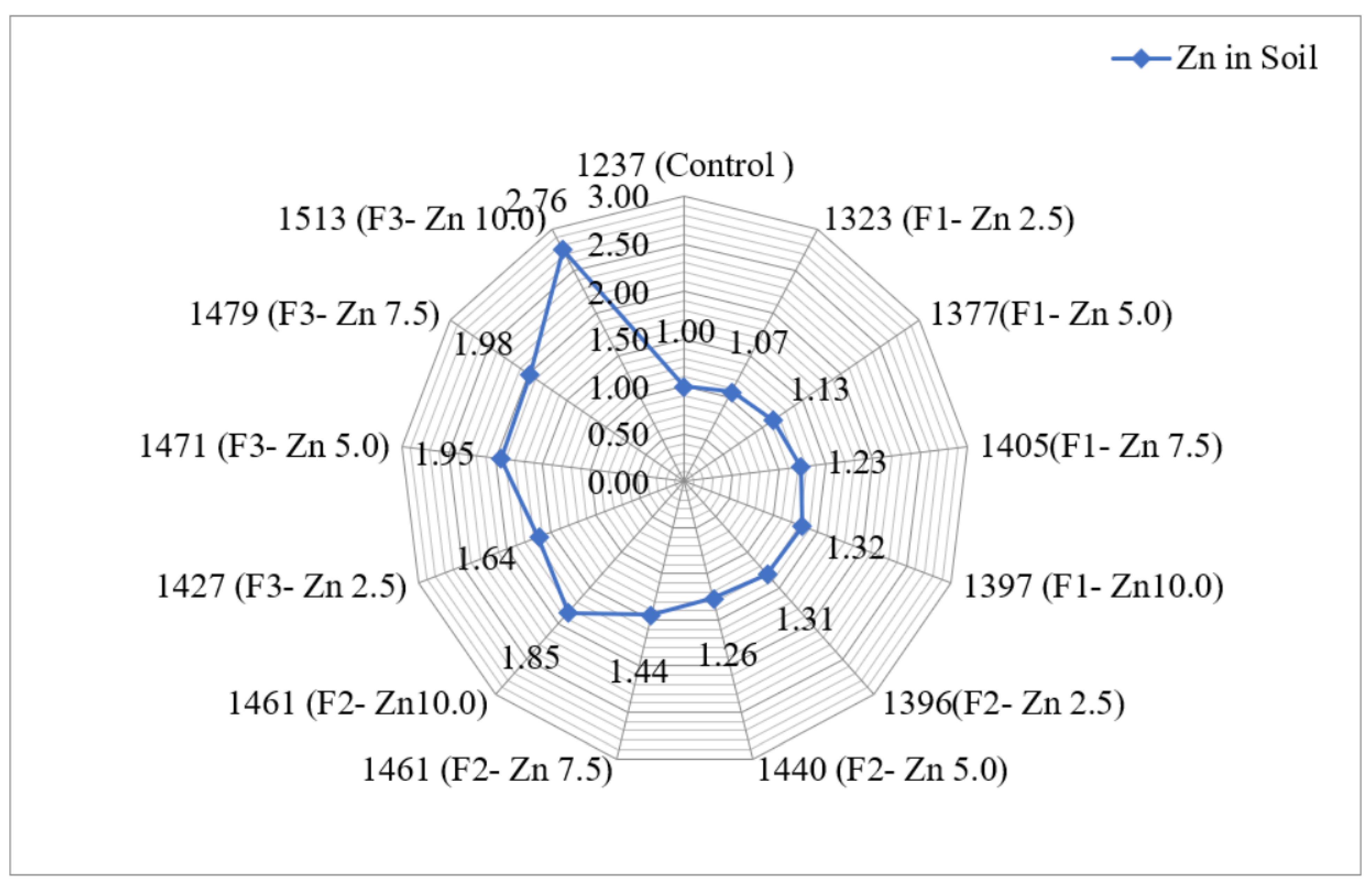Influence of Different Rates and Frequencies of Zn Application to Maize–Wheat Cropping on Crop Productivity and Zn Use Efficiency
Abstract
1. Introduction
2. Materials and Methods
2.1. Experimental Site
2.2. Average Weather Condition during Study Period
2.3. Details of Field Experiments
2.4. Soil and Plant Analysis and Estimation of Zn Use Efficiency
2.5. Statistical Analysis
3. Result and Discussion
3.1. Crop Yields of Maize and Wheat
3.2. Zn Concentration and Uptake
3.3. Zn Content in the Soil
3.4. Zinc Use Efficiency and Apparent Zn Recovery
3.5. Relationship between DTPA-Zn and Grain Yield of Maize and Wheat
4. Conclusions
Author Contributions
Funding
Institutional Review Board Statement
Informed Consent Statement
Data Availability Statement
Acknowledgments
Conflicts of Interest
References
- Behera, S.K.; Shukla, A.K.; Singh, M.V.; Wanjari, R.H.; Singh, P. Yield and zinc, copper, manganese and iron concentration in maize (Zea mays L.) grown on vertisol as influenced by zinc application from various zinc fertilizers. J. Plant Nutr. 2015, 38, 1544–1557. [Google Scholar] [CrossRef]
- Zulfiqar, U.; Hussain, S.; Ishfaq, M.; Matloob, A.; Ali, N.; Ahmad, M.; Alyemeni, M.N.; Ahmad, P. Zinc-Induced effects on productivity, zinc use efficiency and grain biofortification of bread wheat under different tillage permutations. Agronomy 2020, 10, 1566. [Google Scholar] [CrossRef]
- Yadav, R.L.; Dwivedi, B.S.; Prasad, K.; Tomar, O.K.; Shurpali, N.J.; Pandey, P.S. Yield trends and changes in soil organic-C and available NPK in a long-term rice–wheat system under integrated use of manures and fertilisers. Field Crops Res. 2000, 68, 219–246. [Google Scholar] [CrossRef]
- Alexandratos, N.; Bruinsma, J. World Agriculture towards 2030/2050: The 2012 Revision; Food and Agriculture Organization of the United Nations: Rome, Italy, 2012. [Google Scholar]
- Combs, G.F., Jr.; Welch, R.M.; Duxbury, J.M.; Uphoff, N.T.; Nesheim, M.C. Food-Based Approaches to Preventing Micronutrient Malnutrition: An International Research Agenda; CIIFAD: Ithaca, CA, USA, 1996. [Google Scholar]
- Erdal, I.; Yilmaz, A.; Taban, S.; Eker, S.; Torun, B.; Cakmak, I. Phytic acid and phosphorus concentrations in seeds of wheat cultivars grown with and without zinc fertilization. J. Plant Nutr. 2002, 25, 113–127. [Google Scholar] [CrossRef]
- Maxfield, L.; Crane, J.S. Zinc Deficiency. In StatPearls; StatPearls Publishing: Tampa, FL, USA, 2019. Available online: https://www.ncbi.nlm.nih.gov/books/NBK493231 (accessed on 5 August 2022).
- Gupta, S.; Kishore, A.; Alvi, M.F.; Singh, V. Designing better input support programs: Lessons from zinc subsidies in Andhra Pradesh, India. PLoS ONE 2020, 15, e0242161. [Google Scholar] [CrossRef] [PubMed]
- Klassen-Wigger, P.; Geraets, M.; Messier, M.C.; Detzel, P.; Lenoble, H.P.; Barclay, D.V. Micronutrient fortification of bouillon cubes in central and West Africa. Food Fortification in a Globalized World. In Food Fortification in a Globalized World; Elsevier: Amsterdam, The Netherlands, 2018; pp. 363–372. [Google Scholar]
- WHO. The World Health Report 2002: Reducing Risks, Promoting Healthy Life; World Health Organization: Geneva, Switzerland, 2002. [Google Scholar]
- Gibson, R.S. A historical review of progress in the assessment of dietary zinc intake as an indicator of population zinc status. Adv. Nutr. 2012, 3, 772–782. [Google Scholar] [CrossRef]
- Nagender, P.B.; Kumar, P.; Shukla, A.K.; Sharma, M.; Kumar, P. Agronomic zinc biofortification and its impact on mineral composition of eight okra genotypes [Abelmoschusesculentus (L.) Moench] in an acid Alfisol. J. Plant Nutr. 2022. [Google Scholar] [CrossRef]
- Skalny, A.V.; Rink, L.; Ajsuvakova, O.P.; Aschner, M.; Gritsenko, V.A.; Alekseenko, S.I.; Svistunov, A.A.; Petrakis, D.; Spandidos, D.A.; Aaseth, J.; et al. Zinc and respiratory tract infections: Perspectives for COVID-19 (Review). Int. J. Mol. Med. 2020, 46, 17–26. [Google Scholar] [CrossRef] [PubMed]
- Cakmak, I. Enrichment of cereal grains with zinc: Agronomic or genetic biofortification? Plant Soil 2008, 302, 1–17. [Google Scholar] [CrossRef]
- Singh, M.V. Micronutrient nutritional problems in soils of India and improvement for human and animal health. Indian J. Fertil. 2009, 5, 11–56. [Google Scholar]
- Nene, Y.L. Symptoms, cause of control of khaira disease of paddy. Bull. Indian Phytopathol. Soc. 1966, 3, 97–101. [Google Scholar]
- Shukla, A.K.; Behera, S.K. Micronutrient fertilizers and higher productivity. Indian J. Fertil. 2012, 8, 100–117. [Google Scholar]
- Kumar, D.; Patel, K.P.; Ramani, V.P.; Shukla, A.K.; Meena, R.S. Management of Micronutrients in Soil for the Nutritional Security. In Nutrient Dynamics for Sustainable Crop Production; Meena, R.S., Ed.; Springer Nature Pvt. Ltd.: Singapore, 2019; pp. 103–134. [Google Scholar]
- Shukla, A.K.; Behera, S.K.; Satyanarayana, T.; Majumdar, K. Importance of micronutrients in Indian agriculture. Better Crops South Asia 2019, 11, 6–10. [Google Scholar]
- Suganya, A.; Saravanan, A.; Manivannan, N. Role of zinc nutrition for increasing zinc availability, uptake, yield and quality of maize (Zea mays L.) grains: An overview. Commun. Soil Sci. Plant Anal. 2020, 51, 2001–2021. [Google Scholar]
- Rattan, R.K.; Kumar, M.; Narwal, R.P.; Singh, A.P. Soil health and nutritional security–micronutrients. In Proceedings of the Platinum Jubilee Symposium of the Indian Society of Soil Science, New Delhi, India, 22–25 December 2009; pp. 249–265. [Google Scholar]
- Shukla, A.K.; Behera, S.K.; Lenka, N.K.; Tiwari, P.K.; Prakash, C.; Malik, R.S.; Chaudhary, S.K. Spatial variability of soil micronutrients in the intensively cultivated Trans-Gangetic Plains of India. Soil Tillage Res. 2016, 163, 282–289. [Google Scholar] [CrossRef]
- Barak, P.; Helmke, P.A. The chemistry of zinc. In Zinc in Soils and Plants; Robson, A.D., Ed.; Kluwer Academic Publishers: Dordrecht, The Netherlands, 1993; pp. 90–106. [Google Scholar]
- Lopez-Millan, A.F.; Ellis, D.R.; Grusak, M.A. Effect of zinc and manganese supply on the activities of superoxide dismutase and carbonic anhydrase in Medicago truncatula wild type and raz mutant plants. Plant Sci. 2005, 168, 1015–1022. [Google Scholar] [CrossRef]
- Aravind, P.; Prasad, M.N.V. Zinc alleviates cadmium induced toxicity in Ceratophyllumdemersum, a fresh water macrophyte. Plant Phys. Biochem. 2003, 41, 391–397. [Google Scholar] [CrossRef]
- Anwar, S.; Khalilzadeh, R.; Khan, S.; Bashir, R.; Pirzad, A.; Malik, A. Mitigation of Drought Stress and Yield Improvement in Wheat by Zinc Foliar Spray Relates to Enhanced Water Use Efficiency and Zinc Contents. Int. J. Plant Prod. 2021, 15, 377–389. [Google Scholar] [CrossRef]
- Kaya, C.; Higgs, D. Response of tomato (Lycopersicon esculentum L.) cultivars to foliar application of zinc when grown in sand culture at low zinc. Sci. Hortic. 2002, 93, 53–64. [Google Scholar] [CrossRef]
- Fu, X.Z.; Xing, F.; Cao, L.; Chun, C.P.; Ling, L.L.; Jiang, C.L.; Peng, L.Z. Effects of foliar application of various zinc fertilizers with organosilicone on correcting citrus zinc deficiency. Hort. Sci. 2016, 51, 422–426. [Google Scholar] [CrossRef]
- Rosenblueth, M.; Ormeño-Orrillo, E.; López-López, A.; Rogel, M.A.; Reyes-Hernández, B.J.; Martínez-Romero, J.C. Nitrogen fixation in cereals. Front. Microbiol. 2018, 9, 17–94. [Google Scholar] [CrossRef]
- Poole, N.; Donovan, J.; Erenstein, O. Agri-nutrition research: Revisiting the contribution of maize and wheat to human nutrition and health. Food Policy 2020, 16, 1019–1076. [Google Scholar] [CrossRef] [PubMed]
- Singh, S.K.; Chatrath, R.; Mishra, B. Perspective of hybrid wheat research: A review. Indian J. Agric. Sci. 2010, 80, 1013–1027. [Google Scholar]
- Cakmak, I.; Kutman, U.A. Agronomic biofortification of cereals with zinc: A review. Eur. J. Soil Sci. 2018, 69, 172–180. [Google Scholar] [CrossRef]
- Khush, G.S.; Lee, S.; Cho, J.I.; Jeon, J.S. Biofortification of crops for reducing malnutrition. Plant Biotechnol. Rep. 2012, 6, 195–202. [Google Scholar] [CrossRef]
- World Bank. The World Bank Annual Report 2008: Year in Review; World Bank: Washington, DC, USA, 2008; Available online: https://openknowledge.worldbank.org/handle/10986/7524 (accessed on 12 September 2019).
- Sharma, B.D.; Katyal, J.C. Evaluation of amounts, methods and sources of zinc application to wheat in flood plain soils. J. Agric. Sci. 1986, 106, 41–44. [Google Scholar] [CrossRef]
- Amrani, M.; Westfall, D.G.; Peterson, G.A. Influence of water solubility of granular zinc fertilizers on plant uptake and growth. J. Plant Nutr. 1999, 22, 1815–1827. [Google Scholar] [CrossRef]
- Norman, R.; Slaton, N.; Roberts, T. Soil fertility. In Rice Production Handbook; Publication MP192; Hardke, J.T., Ed.; University of Arkansas Cooperative Extension Service: Little Rock, AR, USA, 2013; pp. 69–101. [Google Scholar]
- Sommer, A.L.; Lipman, C.B. Evidence on the indispensable nature of zinc and boron for higher green plants. Plant Physiol. 1926, 1, 231–249. [Google Scholar] [CrossRef]
- Shukla, A.K.; Behera, S.K. Zinc management in Indian Agriculture-Past, present and future. Indian J. Fertil. 2011, 7, 14–33. [Google Scholar]
- Liu, H.X.; Zhang, H.M.; Wang, D.X. Study on yield increasing effect on summer maize nitrogen, zinc complex. J. Jilin Agric. Univ. 2004, 26, 538–541. [Google Scholar]
- Rengel, Z. Availability of Mn, Zn and Fe in the rhizosphere. J. Soil Sci. Plant Nutr. 2015, 15, 397–409. [Google Scholar] [CrossRef]
- Walkley, A.J.; Black, I.A. An estimation of the Degtjareft method for determining of soil organic matter and a proposed modification of chromic acid titration method. Soil Sci. 1934, 37, 29–38. [Google Scholar] [CrossRef]
- Olsen, S.R.; Cole, C.V.; Watanabe, F.S.; Dean, L.A. Estimation of Available Phosphorus in Soil Byextraction with Sodium Bicarbonate; Circular; U.S. Department of Agriculture: Washington DC, USA, 1954; p. 939.
- Hanway, J.J.; Heidal, H. Soil analysis methods as used in Iowa State College, Soil testing Laboratory. Iowa Agric. 1952, 57, 43–45. [Google Scholar]
- Williams, C.H.; Steinbergs, A. Soil sulphur fractions as chemical indices of available sulphur in some Australian soils. Aust. J. Agric. Res. 1959, 10, 340–352. [Google Scholar] [CrossRef]
- Lindsay, W.; Norvell, W.A. Development of a DTPA soil test for zinc iron manganese and copper. Soil Sci. Soc. Am. J. 1978, 42, 421–428. [Google Scholar] [CrossRef]
- Berger, K.C.; Truog, E. Boron determination in soils and plants. Ind. Eng. Chem. Anal. Ed. 1939, 11, 540–545. [Google Scholar] [CrossRef]
- Espinoza-Quiñones, F.R.; Módenes, A.N.; de Pauli, A.R.; Palácio, S.M. Analysis of trace elements in groundwater using ICP-OES and TXRF techniques and its compliance with Brazilian protection standards. Water Air Soil Pollut. 2015, 226, 32. [Google Scholar] [CrossRef]
- Fageria, N.K. The Use of Nutrients in Crop Plants; CRC Press: Boca Raton, FL, USA, 2009. [Google Scholar]
- Shivay, Y.S.; Prasad, R. Zinc-coated urea improves productivity and quality of basmati rice (Oryza sativa L.). under zinc stress condition. J. Plant Nutr. 2012, 35, 928–951. [Google Scholar] [CrossRef]
- Gomez, K.A.; Gomez, A.A. Statistical Procedures for Agricultural Research, 2nd ed.; Wiley: New York, NY, USA, 1984; p. 680. [Google Scholar]
- Yilmaz, A.; Ekiz, H.; Gultekin, I.; Torun, B.; Barut, H.; Karanlik, S.; Bagci, S.A.; Cakmak, I. Effect of different zinc application methods on grain yield and zinc concentration in wheat grown on zinc deficient calcareous soils in Central Anatolia. J. Plant Nutr. 1997, 20, 461–471. [Google Scholar] [CrossRef]
- Slaton, N.A.; Wilson, C.E., Jr.; Ntamatungiro, S.; Norman, R.J.; Boothe, D.L. Evaluation of zinc seed treatments for rice. Agron. J. 2001, 93, 152–157. [Google Scholar] [CrossRef]
- Alloway, B.J. Zinc in Soils and Crop Nutrition, 2nd ed.; International Zinc Association (IZA) and International Fertilizer Association (IFA): Brussels, Belgium; Paris, France, 2008. [Google Scholar]
- Goswami, V.K. Response of wheat (Triticum aestivum L.) to nitrogen and zinc application. Ann. Agric. Res. New Ser. 2007, 28, 90–91. [Google Scholar]
- Tahir, M.; Fiaz, N.; Nadeem, M.A.; Khalid, F.; Ali, M. Effect of different chelated zinc sources on the growth and yield of maize (Zea mays L.). Soil Environ. 2009, 28, 179–183. [Google Scholar]
- Laik, R.; Singh, S.K.; Pramanick, B.; Kumari, V.; Nath, D.; Dessoky, E.S.; Attia, A.O.; Hassan, M.M.; Hossain, A. Improved method of boron fertilization in rice (Oryza sativa L.)–mustard (Brassica juncea L.) cropping system in upland calcareous soils. Sustainability 2021, 13, 5037. [Google Scholar] [CrossRef]
- Doolette, C.L.; Read, T.L.; Li, C.; Scheckel, K.G.; Donner, E.; Kopittke, P.M.; Schjoerring, J.K.; Lombi, E. Foliar application of zinc sulphate and zinc EDTA to wheat leaves: Differences in mobility, distribution, and speciation. J. Exp. Bot. 2018, 69, 4469–4481. [Google Scholar] [CrossRef] [PubMed]
- Cakmak, I. Role of zinc in protecting plant cells from reactive oxygen species. New Phytol. 2000, 146, 185–205. [Google Scholar] [CrossRef]
- Shojaei, H.; Makarian, H. The effect of nano and non-nano zinc oxide particles foliar application on yield and yield components of mungbean (Vigna radiate) under drought stress. Iranian J. Field Crops Res. 2015, 12, 727–737. [Google Scholar]
- Sharma, C.P.; Sharma, P.N.; Bisht, S.S.; Nautiyal, B.D. Zinc deficiency induced changes in cabbage. In Proceedings of the Ninth International Plant Nutrition Colloquim, Coventry, UK, 22–27 August 1982; Scaife, A., Ed.; Commonwealth Agricultural Bureaux: Slough, UK, 1982; Volume 2, pp. 601–606. [Google Scholar]
- Oosterhuis, D.; Hake, K.; Burmester, C. Foliar feeding cotton. Cotton Physiol. Today Natl. Cotton Counc. Am. 1991, 2, 1–7. [Google Scholar]
- Umair Hassan, M.; Aamer, M.; Umer Chattha, M.; Haiying, T.; Shahzad, B.; Barbanti, L.; Nawaz, M.; Rasheed, A.; Afzal, A.; Liu, Y.; et al. The Critical Role of Zinc in Plants Facing the Drought Stress. Agriculture 2020, 10, 396. [Google Scholar] [CrossRef]
- Zhang, Y.Q.; Pang, L.L.; Yan, P.; Liu, D.Y.; Zhang, W.; Yost, R.; Zhang, F.S.; Zou, C.Q. Zinc fertilizer placement affects zinc content in maize plant. Plant Soil 2013, 372, 81–92. [Google Scholar] [CrossRef]
- Harris, D.; Rashid, A.; Miraj, G.; Arif, M.; Shah, H. ‘On-farm’ seed priming with zinc sulphate solution–A cost-effective way to increase the maize yield of resource-poor farmers. Field Crops Res. 2007, 102, 119–127. [Google Scholar] [CrossRef]
- Norouzi, M.; Khoshgoftarmanesh, A.H.; Afyuni, M. Zinc fractions in soil and uptake by wheat as affected by different preceding crops. Soil Sci. Plant Nutr. 2014, 60, 670–678. [Google Scholar] [CrossRef]
- Kumari, K.; Choudhary, R.; Prasad, J.; Solanki, I.S. Long term effect of residual zinc and crop residue on zinc fractionation with different path. J. Pharma. Phytochem. 2018, 7, 2801–2807. [Google Scholar]
- Han, X.; Li, X.; Uren, N.; Tang, C. Zinc fractions and availability to soybeans in representative soils of Northeast China. J. Soils Sediments 2011, 11, 596–606. [Google Scholar] [CrossRef]
- Sharma, B.L.; Bapat, P.N. Levels of micronutrient cations in various plant parts of wheat as influenced by zinc and phosphorus application. J. Indian Soc. Soil Sci. 2000, 48, 130–134. [Google Scholar]
- Khan, H.; Maitlo, A.A. Yield and micronutrients content of bread wheat (Triticum aestivum L.) under a multinutrient fertilizer-Hal-tonic. Int. J. Agric. Biol. 2006, 8, 366–370. [Google Scholar]
- Panwar, A.S.; Shamim, M.; Babu, S.; Ravishankar, N.; Prusty, A.K.; Alam, N.M.; Singh, D.K.; Bindhu, J.S.; Kaur, J.; Dashora, L.N.; et al. Enhancement in productivity, nutrients use efficiency, and economics of rice-wheat cropping systems in India through farmer’s participatory approach. Sustainability 2018, 11, 122. [Google Scholar] [CrossRef]
- Yadav, R.L. Assessing on-farm efficiency and economics of fertilizers N, P and K in rice-wheat system of India. Field Crops Res. 2003, 81, 39–51. [Google Scholar] [CrossRef]
- Rehman, H.U.; Aziz, T.; Farooq, M.; Wakeel, A.; Rengel, Z. Zinc nutrition in rice production systems: A review. Plant Soil 2012, 361, 203–226. [Google Scholar] [CrossRef]
- Ma, Y.B.; Uren, N.C. Effect of aging on the availability of zinc added to a calcareous clay soil. Nutr. Cycl. Agroecosyst. 2006, 76, 11–18. [Google Scholar] [CrossRef]
- Muthukumararaja, T.M.; Sriramachandrasekharan, M.V. Effect of zinc on yield, zinc nutrition and zinc use efficiency of low land rice. J. Agric. Technol. 2012, 8, 551–561. [Google Scholar]
- Genc, Y.; McDonald, G.K.; Graham, R.D. Critical deficiency concentration of zinc in barley genotypes differing in zinc efficiency and its relation to growth responses. J. Plant Nutr. 2002, 25, 545–560. [Google Scholar] [CrossRef]
- Fageria, N.K.; Dos Santos, A.B.; Cobucci, T. Zinc Nutrition of Lowland Rice. Commun. Soil Sci. Plant Anal. 2011, 42, 1719–1727. [Google Scholar] [CrossRef]
- Li, B.Y.; Zhou, D.M.; Cang, L.; Zhang, H.L.; Fan, X.H.; Qin, S.W. Soil micronutrient availability to crops as affected by long term inorganic and organic fertilizer applications. Soil Tillage Res. 2007, 96, 166–173. [Google Scholar] [CrossRef]
- Shambhavi, S.; Kumar, R.; Padbhushan, R.; Verma, G.; Sharma, S.P.; Sharma, S.K.; Sharma, R.P. Dynamics of zinc under long term application of chemical fertilizers and amendments by maize–wheat cropping sequence in Typic Hapludalfs. Soil Use Manag. 2020, 36, 507–523. [Google Scholar] [CrossRef]
- Rutkowska, B.; Szulc, W.; Sosulski, T.; Stępień, W. Soil micronutrient availability to crops affected by long-term inorganic and organic fertilizer applications. Plant Soil Environ. 2014, 60, 198–203. [Google Scholar] [CrossRef]
- Sadeghzadeh, B. A review of zinc nutrition and plant breeding. J. Soil Sci. Plant Nutr. 2013, 13, 905–927. [Google Scholar] [CrossRef]







| Treatment No. | Treatment Details | |
|---|---|---|
| Rate of Zn Application to Maize Crop Only (kg Zn ha−1) | Frequency of Zn Application to Maize Crop Only | |
| T1 | Zn0 0.0 | No Zn applied |
| T2 | Zn1 2.5 | Zn applied first year only |
| T3 | Zn2 5.0 | |
| T4 | Zn3 7.5 | |
| T5 | Zn4 10.0 | |
| T6 | Zn1 2.5 | Zn applied alternate year |
| T7 | Zn2 5.0 | |
| T8 | Zn3 7.5 | |
| T9 | Zn4 10.0 | |
| T10 | Zn1 2.5 | Zn applied every year |
| T11 | Zn2 5.0 | |
| T12 | Zn3 7.5 | |
| T13 | Zn4 10.0 | |
| Treatments (kg Zn ha−1) | Frequency of Application | Maize (Direct) Pooled | Wheat (Residual) Pooled | ||||
|---|---|---|---|---|---|---|---|
| Grain | Straw | Total | Grain | Straw | Total | ||
| Zn0 0.0 | 1237 e | 2946 f | 4183 f | 2934 h | 5042 abcde | 7968 g | |
| Zn1 2.5 | First year only (F1) | 1323 d | 3113 e | 4436 e | 3012 gh | 5156 abcde | 8179 fg |
| Zn2 5.0 | 1377 cd | 3216 de | 4593 de | 3096 fg | 5354 abcd | 8427 ef | |
| Zn3 7.5 | 1405 bcd | 3318 bcd | 4723 cd | 3136 ef | 5401 abcd | 8534 def | |
| Zn4 10.0 | 1397 bcd | 3276 cd | 4673 cd | 3190 def | 5491 abc | 8695 cde | |
| Zn1 2.5 | Alternate year (F2) | 1396 bcd | 3264 cd | 4660 d | 3068 fg | 5409 abcd | 8474 ef |
| Zn2 5.0 | 1440 abc | 3339 bcd | 4779 bcd | 3170 ef | 5486 abc | 8674 cde | |
| Zn3 7.5 | 1461 abc | 3402 abc | 4863 abc | 3248 cde | 5519 abc | 8764 bcde | |
| Zn4 10.0 | 1461 abc | 3395 abc | 4856 abc | 3301 bcd | 5672 abc | 8972 abc | |
| Zn1 2.5 | Every year (F3) | 1427 abc | 3360 bcd | 4786 bcd | 3260 cde | 5420 abcd | 8686 cde |
| Zn2 5.0 | 1471 ab | 3465 ab | 4936 ab | 3332 bc | 5599 abc | 8921 bcd | |
| Zn3 7.5 | 1479 ab | 3533 a | 5012 a | 3401 ab | 5760 ab | 9162 ab | |
| Zn4 10.0 | 1513 a | 3542 a | 5054 a | 3508 a | 5846 a | 9355 a | |
| Treatments (kg Zn ha−1) | Frequency of Application | Maize (Direct) Pooled | Wheat (Residual) Pooled | ||
|---|---|---|---|---|---|
| Grain | Straw | Grain | Straw | ||
| Zn0 0.0 | 21.62 h | 17.16 g | 17.17 j | 14.97 g | |
| Zn1 2.5 | First year only (F1) | 22.10 gh | 17.05 g | 18.03 ij | 15.44 fg |
| Zn2 5.0 | 22.84 gh | 17.77 fg | 18.78 hi | 16.38 ef | |
| Zn3 7.5 | 23.03 fgh | 18.08 fg | 19.05 h | 17.17 de | |
| Zn4 10.0 | 23.41 fg | 18.64 ef | 19.61 fgh | 17.82 cd | |
| Zn1 2.5 | Alternate year (F2) | 24.56 ef | 18.32 ef | 19.38 gh | 17.25 de |
| Zn2 5.0 | 25.15 de | 19.32 de | 20.40 efg | 17.55 cde | |
| Zn3 7.5 | 25.86 de | 19.90 cd | 20.62 def | 18.69 bc | |
| Zn4 10.0 | 26.50 cd | 20.61 c | 21.55 cd | 19.51 ab | |
| Zn1 2.5 | Every year (F3) | 27.88 bc | 22.07 b | 20.68 de | 18.61 bc |
| Zn2 5.0 | 28.57 ab | 22.57 b | 21.78 c | 19.11 b | |
| Zn3 7.5 | 29.30 ab | 23.04 ab | 22.90 b | 19.67 ab | |
| Zn4 10.0 | 30.08 a | 24.23 a | 24.17 a | 20.62 a | |
| Treatments (kg Zn ha−1) | Frequency of Application | Maize (Direct) Pooled | Wheat (Residual) Pooled | ||||
|---|---|---|---|---|---|---|---|
| Grain | Straw | Total | Grain | Straw | Total | ||
| Zn0 0.0 | 27.03 g | 50.52 j | 163.15 h | 51.32 i | 76.02 h | 260.05 i | |
| Zn1 2.5 | First year only (F1) | 29.72 fg | 52.92 ij | 174.25 g | 55.80 h | 80.67 gh | 279.21 h |
| Zn2 5.0 | 32.03 ef | 57.01 hi | 187.37 f | 59.21 gh | 88.60 fg | 302.19 gh | |
| Zn3 7.5 | 32.87 ef | 59.90 gh | 194.66 f | 60.96 fg | 93.24 ef | 313.52 fg | |
| Zn4 10.0 | 33.35 de | 61.12 gh | 197.59 f | 63.80 ef | 97.96 def | 328.36 def | |
| Zn1 2.5 | Alternate year (F2) | 34.30 de | 59.65 gh | 199.38 f | 60.40 fg | 94.24 ef | 314.92 ef |
| Zn2 5.0 | 36.39 cd | 64.39 fg | 212.25 e | 66.28 e | 97.60 def | 334.48 e | |
| Zn3 7.5 | 37.83 c | 67.57 ef | 221.88 de | 67.95 de | 103.09 bcde | 347.28 de | |
| Zn4 10.0 | 38.98 bc | 69.83 de | 228.86 cd | 71.99 cd | 110.61 abc | 370.35 cd | |
| Zn1 2.5 | Every year (F3) | 39.77 bc | 74.23 cd | 239.10 c | 68.26 cde | 101.64 cde | 343.87 cde |
| Zn2 5.0 | 42.07 ab | 78.21 bc | 252.20 b | 72.67 c | 107.41 bcd | 366.89 cd | |
| Zn3 7.5 | 43.43 a | 81.47 ab | 262.01 ab | 78.57 b | 112.43 ab | 390.43 b | |
| Zn4 10.0 | 45.40 a | 85.96 a | 273.60 a | 85.71 a | 120.21 a | 420.33 a | |
Publisher’s Note: MDPI stays neutral with regard to jurisdictional claims in published maps and institutional affiliations. |
© 2022 by the authors. Licensee MDPI, Basel, Switzerland. This article is an open access article distributed under the terms and conditions of the Creative Commons Attribution (CC BY) license (https://creativecommons.org/licenses/by/4.0/).
Share and Cite
Kumar, D.; Patel, K.C.; Ramani, V.P.; Shukla, A.K.; Behera, S.K.; Patel, R.A. Influence of Different Rates and Frequencies of Zn Application to Maize–Wheat Cropping on Crop Productivity and Zn Use Efficiency. Sustainability 2022, 14, 15091. https://doi.org/10.3390/su142215091
Kumar D, Patel KC, Ramani VP, Shukla AK, Behera SK, Patel RA. Influence of Different Rates and Frequencies of Zn Application to Maize–Wheat Cropping on Crop Productivity and Zn Use Efficiency. Sustainability. 2022; 14(22):15091. https://doi.org/10.3390/su142215091
Chicago/Turabian StyleKumar, Dileep, Khusvadan C. Patel, Vinubhai P. Ramani, Arvind K. Shukla, Sanjib Kumar Behera, and Ravi A. Patel. 2022. "Influence of Different Rates and Frequencies of Zn Application to Maize–Wheat Cropping on Crop Productivity and Zn Use Efficiency" Sustainability 14, no. 22: 15091. https://doi.org/10.3390/su142215091
APA StyleKumar, D., Patel, K. C., Ramani, V. P., Shukla, A. K., Behera, S. K., & Patel, R. A. (2022). Influence of Different Rates and Frequencies of Zn Application to Maize–Wheat Cropping on Crop Productivity and Zn Use Efficiency. Sustainability, 14(22), 15091. https://doi.org/10.3390/su142215091









